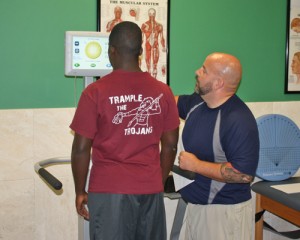
BERLIN — With the fall high school sports season now in full bloom, the potential for concussions and head injuries has returned, but one local physical therapy establishment is helping make sure local student-athletes, coaches and trainers are better prepared for diagnosis and management.
In late July, the State Board of Education handed down emergency regulations aimed at further protecting Maryland’s high school athletes from head injuries and concussions, including strict guidelines for returning to play. Worcester County and the other schools in the Bayside Conference had already been implementing many of the state’s mandates, including a medical assessment after a suspected concussion or head injury before a player could return to the field.
Local coaches and trainers have been required to take courses to recognize the symptoms of head injuries and make educated decisions about a player’s fitness to return to play, and while most have become adept at recognizing a head injury after the fact, they haven’t been able to tell the extent of the injury without a real understanding of the athlete’s balance and cognitive function before the trauma.
That has changed this year as local schools have a new tool at their disposal for diagnosing and managing head injuries and concussions. Atlantic Physical Therapy (APT) owner and high school sports advocate Bob Hammond has put in place at his facilities a machine that measures and stores a baseline for balance and other cognitive functions for athletes. The results are saved and can be compared to later tests if head injuries or concussions are suspected.
Called the Biodex Concussion Management Program, the sophisticated machine measures the balance and basic cognitive ability of a student-athlete and saves the information. A printout of the information is also given to the coaching staff to include in each athlete’s folder. If and when a head injury or concussion occurs, the student-athlete is subjected to the same six-minute balance test and the new readouts are compared to the baseline test. In some cases, the test can be re-administered until the new sample closely matches the baseline, signaling the damage has been repaired and a return to play is safe.
“It gives us a baseline we can save,” said APT physical therapist and personal trainer Dave Bennett this week. “If there’s a suspected injury, we can bring the athlete back and compare their new result with their baseline.”
Hammond has made the machine available to all student-athletes in Worcester County, from the high school athletes down to the Pop Warner football players. On Tuesday, the entire Snow Hill High School football team arrived at APT’s facility in Ocean Pines to have their baseline tests recorded.
Essentially, each player stood on the machine’s base with their feet in designated positions and focused on a screen in front of them with what can be best described as a target with concentric circles. On the screen is a cursor, which moves when the athlete shifts balance. The athlete first attempts to keep the cursor in the center by shifting their weight ever so slightly.
Then, the athlete completes the same test with his or her eyes closed and in most cases, the cursor moves from the center. The process is repeated with a two-inch soft foam mat under their feet and while most of the Snow Hill players were able to keep the cursor in the center with their eyes open, the dot moved erratically in some cases when the athlete’s eyes were closed.
While most of the coaches and athletic trainers are trained to recognize the symptoms of concussions on the field, the program provides them with a scientific tool to later confirm their suspicions and get the athlete on a management program.
“There are a lot of sideline tests by trainers and coaches, but these are good athletes and they can fake them,” he said. “They can’t fake these.”
Snow Hill Head Coach Todd Lampman said on Tuesday the APT’s Biodex machine provides coaches and trainers with another weapon in the arsenal for concussions and head injuries.
“This gives us more information to better serve the student-athletes,” he said. “We can present more information to our doctors and trainers and make better decisions about concussion management and safe return to play.”
While one of the goals is determining a safe return to play for the student-athletes, the ultimate goal is the well-being of the players.
“We want our athletes to get back on the field, but at the same time, our first priority is their safety,” Lampman said. “Concussions are serious. If one of our kids has a suspected concussion, this is another tool to help us make the decision when, and if when, it’s safe to resume playing.”
Lampman’s players dutifully went through the tests on Tuesday, recording baselines Lampman hopes remain in the files.
“We hope we never have to bring any of these kids back, but this is a nice tool to establish a baseline,” he said. “It’s a nice tool in the training arsenal.”
